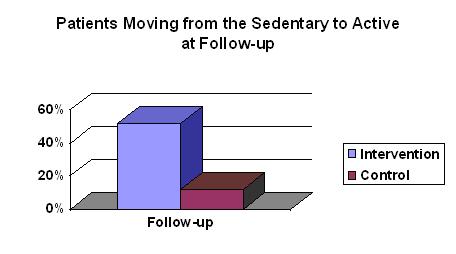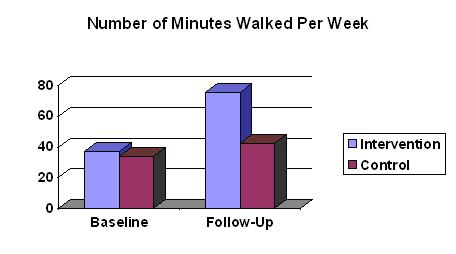Program Synopsis
Designed to increase physical activity among sedentary individuals, this intervention delivered by primary care providers assesses a patient’s stage of change for increasing physical activity and provides the patient with a stage-matched protocol and brief counseling as well as a booster call 2 weeks later. The study showed increases in patients moving from the sedentary to the active stage and in minutes walked.
Program Highlights
Program Materials
Preview and order the materials from the developer
Program Scores
The Need
Increasing physical activity among the sedentary is essential to preventing and controlling such chronic ailments as coronary artery disease, hypertension, obesity, and depression. Despite the critical role that physical activity plays in decreasing the risk of disease, the majority of Americans are not active at levels that can benefit their health. Primary care providers are looked to more and more for their role in promoting increased physical activity. Though primary care providers agree they are responsible for giving advice and guidance on physical activity, few are convinced their efforts will be effective. This is due to barriers such as limited time, reimbursement, perceived effectiveness, and a lack of training in behavioral counseling which must first be addressed.
The Program
The program is based on the "stages of change" model and is designed to increase social support and self-efficacy, reduce perceived barriers to activity, and increase awareness of the benefits of activity. PACE, Patient-Centered Assessment and Counseling for Exercise, requires patients to complete an assessment while in the primary care provider's waiting room. Based on their score, the patient receives a stage-matched protocol to partially complete before seeing the provider. During the physician visit, patient and provider review the protocol and discuss stage-relevant information during 3-5 minutes of counseling. The provider completes the recommended sections of the protocol and provides the patient with a copy. Two weeks later, patients receive a brief booster call from a health professional.
Community Preventive Services Task Force Finding
 This program uses an intervention approach recommended by the Community Preventive Services Task Force: individually-adapted health behavior change programs (Physical Activity).
This program uses an intervention approach recommended by the Community Preventive Services Task Force: individually-adapted health behavior change programs (Physical Activity).
Time Required
The initial patient assessment form requires approximately 5 minutes. Patients should also spend 5-10 minutes reviewing the appropriate protocol before seeing the provider. The PACE counseling session with the provider requires approximately 3-5 minutes. A 10-minute follow-up phone call is also recommended.
Intended Audience
Participants were primary care providers and healthy, sedentary (engaging in moderate exercise less than 2 hours per week) adult patients in California. The average age of patients was 39 years; 84% were female, 72% were White and 28% were ethnic-racial minority group members which were Asian or Pacific Islander, Black, and Hispanic.
Suitable Settings
The intervention is suitable for implementation in a physician's office.
Required Resources
Required resources include the PACE patient assessment form, PACE patient counseling protocols, a patient tip sheet, and the PACE provider's manual.
About the Study
For the study, 10 control physicians were matched with 12 intervention physicians on medical specialty and patient demographics. A volunteer sample of 255 patients in these practices were recruited to the study and assigned to the same arm as their physician. Intervention physicians were trained to deliver PACE; control physicians were trained in hepatitis B detection. Intervention patients completed a PACE assessment form while in the physician's waiting room. The form was scored and used to categorize the patient into one of three stages: "precontemplation" (not active and not intending to become active), "contemplation" (little or no activity but intending to become active), and "active" (physically active on a regular basis).
Patients were given a protocol to read and partially complete before seeing the physician. During the visit, the physician reviewed the protocol with the patient and discussed stage-relevant information during the 3 to 5 minute counseling session. The physician completed the recommendations section of the protocol, and a copy was provided for the patient. Intervention patients also received a 10-minute booster phone call from a health educator to answer questions and discuss progress. Patients were interviewed before and 4 to 6 weeks after their scheduled visit.
Results indicated:
- At follow-up, a larger proportion (52%) of the intervention patients moved from the contemplator (sedentary) group to the active group compared to control subjects (12%).
- On the self-report measure of minutes walking per week, the intervention group improved significantly more over time than the control group (+37 versus +7, respectively). These self-reports were validated with a subsample of patients who wore an accelerometer -- an activity monitor that assesses walking.


Publications
Patrick K, Sallis JF, Long B, Calfas KJ, Wooten W, Heath G, Pratt M. (1994). A New Tool for Encouraging Activity: Project PACE. The Physician and Sportsmedicine, 22 (11), 45-52.


